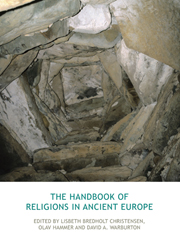Book contents
- Frontmatter
- Contents
- A note on Greek and Latin sources
- Abbreviations and short titles
- 1 Introduction
- PART I PREHISTORIC RELIGIONS
- PART II ANCIENT EUROPE IN THE HISTORICAL PERIOD
- 12 Minoan and Mycenaean religion
- 13 Etruscan religion
- 14 The religions of the Iberian Peninsula
- 15 Italic religion
- 16 Roman religion
- 17 Ancient Greek religion
- 18 The Graeco-Roman cult of Isis
- 19 The cult of Mithras
- 20 Religious Platonism: philosophy and religion in the Platonic tradition
- 21 Insular Celtic religion
- 22 Continental Germanic religion
- 23 Pre-Christian Anglo-Saxon religion
- 24 Old Norse religion
- 25 Slavic religion
- 26 Baltic religion
- 27 Religion in prehistoric Finland
- 28 Sami religion
- Timeline of key dates
- Contributors
- References
- Index
28 - Sami religion
from PART II - ANCIENT EUROPE IN THE HISTORICAL PERIOD
- Frontmatter
- Contents
- A note on Greek and Latin sources
- Abbreviations and short titles
- 1 Introduction
- PART I PREHISTORIC RELIGIONS
- PART II ANCIENT EUROPE IN THE HISTORICAL PERIOD
- 12 Minoan and Mycenaean religion
- 13 Etruscan religion
- 14 The religions of the Iberian Peninsula
- 15 Italic religion
- 16 Roman religion
- 17 Ancient Greek religion
- 18 The Graeco-Roman cult of Isis
- 19 The cult of Mithras
- 20 Religious Platonism: philosophy and religion in the Platonic tradition
- 21 Insular Celtic religion
- 22 Continental Germanic religion
- 23 Pre-Christian Anglo-Saxon religion
- 24 Old Norse religion
- 25 Slavic religion
- 26 Baltic religion
- 27 Religion in prehistoric Finland
- 28 Sami religion
- Timeline of key dates
- Contributors
- References
- Index
Summary
In traditional Sami thought, a person's name was not just a label used to distinguish him or her from others; it also played a crucial role in describing a person's character. Every name was related to a set of personal characteristics, and this meant that it was very important for parents to choose names for their children with great care. Even more importantly, the name was crucial in determining who the child would become, not only in terms of personality, but more concretely, in terms of which ancestor would be reborn in the child. As the sources tell us, a common dream among pregnant women was of an ancestor begging her to give the expected child his or her name, so that he or she would no longer have to live in the tedious land of the departed. Before the naming ceremony, the parents therefore had to choose an appropriate name for the child from among the names of the ancestors. If the decision was difficult, they could get help by praying to Saaraahka (the most important divinity), the father could perform a divination ritual, or the parents could ask the nåejtie (the foremost of the ritual specialists) to perform a divination ritual. The ancestor whose name was given to the child was regarded as being reborn in the child.
APPROACHING THE THEME
Indigenous Sami religion
This chapter deals with what is usually called “indigenous Sami religion”, the most common designation in English of the pre-Christian religious traditions of the Sami.
- Type
- Chapter
- Information
- The Handbook of Religions in Ancient Europe , pp. 392 - 408Publisher: Acumen PublishingPrint publication year: 2013



